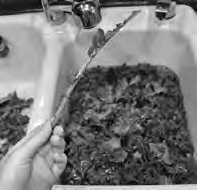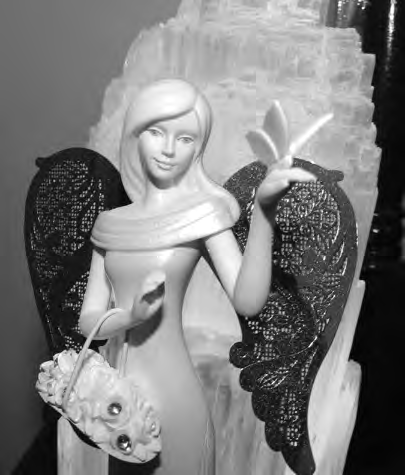100 Perks of Having Cancer: Plus 100 Health Tips for Surviving It (48 page)
Read 100 Perks of Having Cancer: Plus 100 Health Tips for Surviving It Online
Authors: Florence Strang
Tags: #Health; Fitness & Dieting, #Diseases & Physical Ailments, #Internal Medicine, #Oncology, #Cancer, #Medicine & Health Sciences, #Clinical, #Medical Books, #Alternative Medicine, #Medicine

of arthritis, heart disease, cancer, and a number of autoimmune diseases.
Kale is an incredibly effective anti-inflammatory food, potentially pre-
venting and even reversing these illnesses.
●
Iron content:
It is a common myth that vegetarians are anemic. In fact,
the number of nonvegetarians with iron deficiencies is on the rise. Kale
is a great source of iron and, per calorie, even has more iron than beef!
●
Calcium content:
Kale contains more calcium per calorie than milk (90
mg per serving), and the calcium is also more easily absorbed by the body
than dairy products.
194
100 Perks of Having Cancer
●
Fiber content:
Like protein, fiber is a macronutrient, which means we
need it every day. Many people don’t eat nearly enough and the deficiency
is linked to heart disease, digestive disorders, and colon cancer, along
with everyday annoyances like bloating and constipation. A one-cup serv-
ing of kale not only contains 10 percent of the recommended daily intake
of fiber but as an added bonus, also provides over two grams of protein.
●
Omega fatty acids:
Essential omega fats (the “good” kind of fats) play
an important role in our health. A serving of kale contains an impressive
121 mg of omega-3 fatty acids and 92 mg of omega-6 fatty acids, which
is great when you’re trying to boost your omega-3s.
●
Immunity properties:
Immunity is the key to cancer resistance. Kale is
an incredibly rich source of immune-boosting carotenoid and flavonoid
antioxidants that provide vitamins A and C. One serving of kale has 134
percent of the U.S. recommended daily allowance for vitamin C and an
impressive 206 percent of the U.S. recommended daily allowance for vita-
min A—that’s 10,302 IUs!
●
Environmental sustainability:
Kale grows to maturity in fifty-five to sixty
days. Kale can grow in most climates and is relatively easy to grow at
home or on a farm. Just for comparison, raising one pound of beef
requires sixteen pounds of grain, eleven times as much fossil fuel, and
2,400 more gallons of water than growing one pound of kale.
●
Low cal:
One cup of fresh kale has 30 calories and less than one mil-
ligram of fat per cup. Nuff said.
●
Cancer-fighting kick:
Kale belongs to the botanical family known as
cruciferous, which has broccoli, cauliflower, and Brussels sprouts as its
siblings. These vegetables are extremely high in phytochemicals, sulfora -
phane, and indole-3-carbinol. These are not just fancy words, they are
also substances that have been shown to protect against cancer.
And I am pretty sure if kale were still boasting, it would have to add, “I
offer many varieties to choose from like Redbor, Red Russian, Kamome Red,
and Premier.”
Perk #49: Cancer Motivated Me to Eat Healthier
195
Unlike broccoli, cauliflower, and Brussels sprouts, kale can actually dis-
guise itself as a junk food. Yes, folks, you heard it here first: kale chips! Just
think of how cool it would be to sit in front of the TV, eat chips, and fight
cancer at the same time. (Just to be clear here, it’s the kale chips,
not
the sit-
ting in front of the TV that fights cancer.) Kale shrinks to one
half its amount with baking, which is great because you can eat
Kale, any way you
twice as much without even knowing it. For this recipe, if you
make it, is a great
start with 12 cups, you’ll have 6 when you finish, but you can
addition to your
really start off with any amount of kale, just know that you’ll end
healthy diet.
up with half that amount when they’re done.
KALE CHIPS
YIELD: 6 CUPS
1 bunch kale (12 cups after stems removed), fresh from a farmers market
if you can, as kale’s flavor declines rapidly after it’s picked;
curly, flat, and Siberian varieties work well.
1 to 2 tablespoons organic extra virgin olive oil
(or more depending on the amount of kale)
Desired seasoning: sea salt, Old Bay, cumin, garlic,
or other seasonings, to taste
1. Preheat oven to 300°F.
2. Make sure your kale is well washed. I add about 1/8 to 1/4 cup of salt to
the water in a full sink for extra cleaning as this helps remove any critters or
dirt still clinging. Remove the stems and rip the leaves into large chip-size
pieces. Not too small. Remember, they will shrink quite a bit.
3. Dry the kale extremely well. I can’t emphasize this enough. They should be
dry; not damp, not almost dry, but completely dry. Really, really dry. Bone
dry. Am I making myself clear? I left mine to sit out on dry paper towels for
a few hours.

196
100 Perks of Having Cancer
4. Place leaves in a large bowl and drizzle with the olive oil. You want to coat
each piece without drenching it. Work the oil into each leaf with your finger-
tips. (Then work the oil into your cuticles—it’s great.)
5. Place pieces in a single layer on a cookie sheet and season as you like, or
you can season the oil for a more uniform flavor.
6. Bake for 20 minutes.
7. Let cool for 10 minutes and pig out . . . er, veg out.
Store in airtight, firm bowls, not bags, as the chips are very delicate.
Hail to the kale!
When boiling or sautéing kale or putting it in a shake,
use the stalks, as they hold additional nutrition.
However, when making chips, the stalks become sticklike,
so remove them (unless you are partial to eating sticks).
NUTRITION:
1 medium bunch raw (about 12 cups after stems removed) yields 6 cups of
chips. Serving size: 1 cup; calories: 60; fat: 0; fiber: 2 grams; protein: 4 grams;
vitamin A: 412% of the RDA; vitamin C: 268% of the RDA; vitamin K: 1368%
of the RDA; iron: 12% of the RDA; calcium: 18% RDA; carbs: 14 grams.





Perk #50
Receiving Special Gifts
F
or me, one of the nicest perks of
having cancer was being showered
with get-well cards and gifts. Every gift,
big and small, was special to me. Some
gifts, however, in addition to being a
thoughtful gesture, also had an inter-
esting story behind them. The figurine
of an angel holding a butterfly (pic-
tured right), given to me by my friend
Ronnie, is one such gift.
For many years, the angels have
played an important role in my life.
(You can get away with saying stuff like
that once you have had cancer.) I call
upon them on a daily basis for mun-
dane things, such as helping me to
locate lost items and keeping me safe
on the highway. They have also helped me to weather the stormy times
in my life. The angels have seen me through a painful divorce and my
son’s diagnosis of autism. I know they are about when I feel their peace -
ful presence and I get a sense of knowing that everything will be okay. The
angels also let me know when they are at work with the symbol of a blue
butterfly.
Never before have I needed reassurance from my angels as much as I
did in the spring of 2011 when I was diagnosed with breast cancer. Even
though I endured many uncomfortable and painful procedures, nothing can
compare to the mental anguish of waiting for test results. Finding out about
my diagnosis was not the worst part of this journey. The worst part of the
